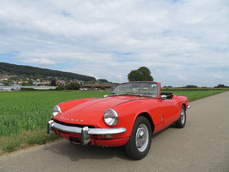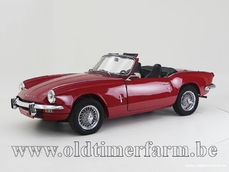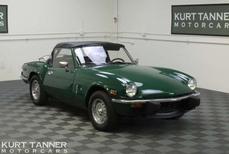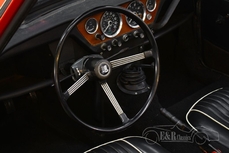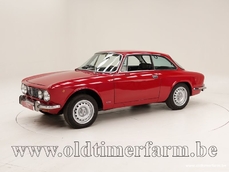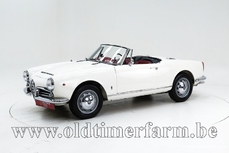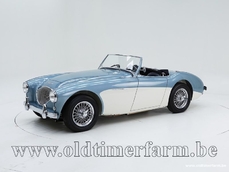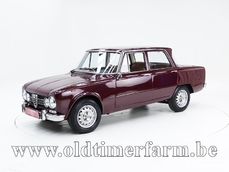Triumph Spitfire 1500 '78 1978
General description :
The Triumph Spitfire was a small British two-seat sports car, introduced in October 1962. The vehicle was based on a design produced for Standard-Triumph in 1957 by Italian designer Giovanni Michelotti. The codename for the vehicle was the "Bomb". The car was largely based on the Triumph Herald saloon, and throughout its life was built at the Standard-Triumph works at Canley, Coventry. In 1973 in the United States & Canada and 1975 in the rest of the world, the 1500 engine was used to make the Spitfire 1500; though in this final incarnation the engine was rather rougher and more prone to failure than the earlier units, torque was greatly increased which made it much more drivable in traffic. The reason for the engine problems was due to continued use of three main bearings for the crank shaft. While the rest of the world saw 1500s with the compression ratio reduced to 8.0:1, the American market model was fitted with a single Zenith-Stromberg carburettor and a compression ratio reduced to 7.5:1 to allow it to run on lower octane unleaded fuel and after adding a catalytic converter and exhaust gas recirculating system, the engine only delivered 100 bhp (75 kW) with a fast 0-60 time of 14.3 seconds. The notable exception to this was the 1976 model year, where the compression was raised to 9:1. This model produced over 100 mph (160 km/h). The American market Spitfire 1500 is easily identified by the big plastic over-riders and wing mounted reflectors on the front and back wings. The US specification models up to 1978 still had chrome bumpers, but on the 1979 and 1980 models these were replaced by black rubber bumpers with built-in over-riders. Chassis extensions were also fitted under the boot to support the bumpers. Detail improvements continued to be made throughout the life of the Mark IV, and included reclining seats with "chequered brushed nylon centre panels" and head restraints, introduced for domestic market cars early in 1977 along with a new set of column stalk operated minor controls (as fitted already in the TR7) replacing the old dashboard mounted knobs and switches.[5] Also added for the model's final years were a wood dash, hazard flashers and an electric screen washer, in place of the previous manual pump operated ones. Options such as the hard top, tonneau cover, map light and overdrive continued to be popular, though wire wheels ceased to be available. The 1980 model was the last and the heaviest of the entire run weighing in at 1,875 lb (850.5 kg). Base prices for the 1980 model year were $5,995 in the US and £3631 in the UK.[2] The last Spitfire, an Inca Yellow UK-market model with hardtop and overdrive, rolled off the assembly line at Canley in August 1980, shortly before the factory closed. It was never sold and is now displayed at the British Motor Heritage museum at Gaydon. Specifications Bodywork Length : cm (in): 378 (148.8) Width : cm (in): 149 (58.7) Height : cm (in): 121 (47.4) Wheelbase : cm (in) : 211 (83.1) Weight: kg (lb) : 800 (1766) Mechanics. Displacement : straight 4 1493 cc (91 ci), front-mounted Valve gear : 8 Fuel system : 2 SU carburettors Gearbox : 4-speed, manual Driven wheels : rear-wheel drive LHD Maximum power : 72 bhp at 5500 rpm Maximum torque : 111 Nm at 3000 rpm Maximum speed : 161 km/h(100 mph)
http://www.oldtimerfarm.be/en/collection-cars-for-sale/5589/triumph-spitfire-1500-78.php
1978 Triumph Spitfire 1500 '78 is listed sold on ClassicDigest in Aalter by Oldtimerfarm Dealer for €14950.
Car Facts
Car type : Car Make : Triumph Model : Spitfire Model Version : 1500 '78 Engine size : 0.0 Model Year : 1978 Location : Aalter
Sold
Seller Information
Sold
People who viewed this Triumph Spitfire also viewed similar Triumph listed at ClassicDigest
Other cars listed for sale by this dealer
About Triumph
Triumph, a name synonymous with classic sports cars and innovative designs, has a rich and storied history in the automotive world.The Triumph story began in the late 19th century when the company originally produced bicycles and then expanded into motorcycles. However, it was in the 1920s that Triumph ventured into the production of automobiles. Over the years, Triumph became renowned for its high-quality vehicles that combined performance with style.
One of Triumph's most iconic models was the TR3, introduced in the late 1950s. It was a classic British sports car, loved for its simple yet elegant design and thrilling driving experience. The TR3 was a symbol of affordable sports car enjoyment, and it set the stage for a series of successful TR models, including the TR4, TR5, and TR6.
In addition to sports cars, Triumph made a name for itself with Michelotti-designed sedans. The Triumph Herald, introduced in the early 1960s, was a compact family car that boasted stylish design and solid engineering. Later on, the Triumph 2000 and 2500 sedans catered to a more upscale market and earned a reputation for their comfortable rides and elegant looks.
However, despite its successes, Triumph faced numerous challenges over the years, including financial difficulties and ownership changes. In the 1980s, British Leyland, the company that owned Triumph, underwent significant restructuring, and the Triumph brand was gradually phased out.
The demise of Triumph was indeed sad and, to some extent, disgraceful. The company that had produced beloved sports cars and well-regarded sedans was slowly fading away. In 1984, the last Triumph-badged car rolled off the production line, marking the end of an era.
Although the Triumph name disappeared, its legacy lives on. Enthusiasts and collectors continue to cherish classic Triumph sports cars like the TR3, TR6, and Spitfire, as well as the unique charm of Triumph sedans. Triumph remains a symbol of British automotive heritage and the enduring appeal of classic sports cars.
In conclusion, Triumph's history is a blend of classic sports car excellence and innovative sedan design. Its sad and disgraceful demise serves as a reminder of the challenges faced by many automakers over the years, but the spirit of Triumph lives on in the hearts of automotive enthusiasts around the world.
















